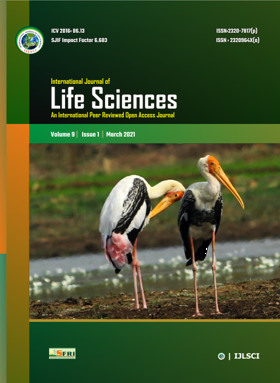Evaluation of phytochelatin mediated heavy metal (HM) uptake efficiency of wheatgrass plant from heavy metal contaminated soil
Keywords:
Wheatgrass plant, Heavy metals, Phytochelatin, PhytoremediationAbstract
Phytoextraction - form of phytoremediation involves growth of tolerant plants in contaminated soils; plants take up large amounts of heavy metals from the soil, depleting it of the target pollutants and translocating them to the aerial parts of the plant. In the present study phytochelatin synthesis in Wheatgrass (Triticum aestivum) was used as a measure for phytoremediation of heavy metal (Cr, Pb, Cd) contaminated soil for a period of 14 days. Phytochelatin (PCs) – small metal binding polypeptides are synthesized non-translationally from reduced glutathione by enzyme phytochelatin synthase in hyperaccumulating plants only when exposed to heavy metal toxicity which translocate contaminants in plant vacuoles making them inert. Wheat grass is a hyperaccumulator species for Cr, Cd, Pb, Zn etc. So, PC content in Wheatgrass plant exposed to varying concentration of heavy metals was assessed by Ellman’s Test Protocol and changes in factors influencing phytoextraction like plant growth rate, biomass, phytotoxicity were observed alongside to study the efficiency of phytoremediation. An increase in PC content was observed in the order Control < Cr < Pb <Cd. With the plant exposed to Cd producing maximum phytochelatin. Gradual decrease in plant growth rate and biomass content was observed after tenure of 14 days
Downloads
References
Allison, L. E. & Black, C. A., 1965. Organic Carbon. In: Methods of Soil Analysis. s.l.:s.n.
Athar, R. & Ahmad , M., 2002. Heavy Metal Toxicity: Effect on Plant Growth and Metal Uptake by Wheat, and on Free Living Azotobacter. Water, Air, & Soil Pollution 138, p. 163.
Bidlack, J. E. & Jansky, S., 2011. Lab Manual t/a Introductory Plant Biology. In: Lab Manual t/a Introductory Plant Biology. s.l.:s.n.
Emamverdian, A., Ding, Y., Mokhberdoran, F. & Xie, Y., 2015. Heavy Metal Stress and Some Mechanisms of Plant Defense Response. The Scientific World Journal.
Garg, N. & Kaur, H., 2012. Response of Antioxidant Enzymes, Phytochelatins and Glutathione Production Towards Cd and Zn Stresses in Cajanus cajan (L.) Millsp. Genotypes Colonized by Arbuscular Mycorrhizal Fungi. Journal of Agronomy and Crop Science.
Gaskin, S., Soole, K. & Bentham, R. H., 2008. 'Screening of Australian Native Grasses for Rhizoremediation of Aliphatic Hydrocarbon-Contaminated Soil'. pp. 378-389.
Gaur, A. & Adholeya, A., 2004. Prospects of arbuscular mycorrhizal fungi in phytoremediation of heavy metal contaminated soils. Current Science, pp. 528-534.
Hentz, S. & McComb, J., 2015. Cadmium Uptake, Growth and Phytochelatin Contents of Triticum Aestivum in Response to Various Concentrations of Cadmium. World Environment 2012, pp. 44-50.
Jadia, C. & Fulekar, M. H., 2008. Phytoremediation of heavy metals. African Journal of Biotechnology Vol. 8 (6), pp. 921-928.
Keltjens, W. G. & Beusichem, M. L., 1998. Phytochelatin as biomarkers for heavy metal stress in maize (Zea mays L.) and wheat (Triticum aestivum L.):Combined effects of copper. Plant and soil, Volume 203, pp. 119-126.
Kulakowl & Erickson, L., 2000. A Nation wide field test of Petroleum contaminated soils. Proceedings of the 2000 Conference on Hazardous Waste Research.
Lal, S., Kumar, R. & Ahmad, S., 2019. 2019 Exploring the survival tactics and plant growth promising traits of root-associated bacterial strains under Cd and Pb stress. Ecotoxicology and Enviromental Safety Volume 170, pp. 267-277.
Lasat, M. M., 2000. “Phytoextraction of metals from contaminated soil: a review of plant/soil/metal interaction and assessment of pertinent agronomic issues,”. Journal of Hazardous Substance Research, vol. 2, pp. 1-25.
Meier, U., 2001. Growth stages of mono-and dicotyledonous plants. In: s.l.:s.n.
Ouzounidou, G., Moustakas, M. & Eleftheriou, 1997. Physiological and Ultrastructural Effects of Cadmium on Wheat (Triticum aestivum L.) Leaves. Archives of Environmental Contamination and Toxicology volume 32, pp. 154-160.
Paschke, M. W., Redente, E. F. & Levy, D. B., 2009. Zinc toxicity thresholds for important reclamation grass species of the western united states. Environmental Toxicology and Chemistry.
Pehlivan, E. & Ozkan, A. M., 2009. “Adsorption of Cu2+ and Pb2+ ion on dolomite powder,”. Journal of Hazardous Materials, vol. 167.
Qadir, M. et al., 2018. Economics of salt‐induced land degradation and restoration (Article). Natural Resources Forum.
Rafati, M. et al., 2011. Phytoremediation Potential of Populus Alba and Morus alba for Cadmium, Chromuim and Nickel Absorption from Polluted Soil. International Journal Environmental Research, pp. 961-970.
Rajeshwari, T. R. & Sailaja, N., 2014. IMPACT OF HEAVY METALS ON ENVIRONMENTAL POLLUTION. Journal of Chemical and Pharmaceutical Sciences, pp. 175-181.
Salt, D. E., Smith, R. D. & Raskin, I., 1998. Phytoremediation. Annual review of plant physiology and plant molecular Biology.Vol 49, 49(June 1998), pp. 643-668.
Thangavel, P. & Subbhuraam, C. V., 2004. Phytoextraction: Role of Hyperaccumulators in Metal Contaminated Soils. Proceedings of Indian National Science Academy, pp. 109-130.
Downloads
Published
How to Cite
Issue
Section
License
Copyright (c) 2021 Tirodkar Tanuja V, Ambre Snehal J, Vaishnavi Bhike, Vighnesh Ghag

This work is licensed under a Creative Commons Attribution-NonCommercial-NoDerivatives 4.0 International License.
Open Access This article is licensed under a Creative Commons Attribution 4.0 International License, which permits use, sharing, adaptation, distribution and reproduction in any medium or format, as long as you give appropriate credit to the original author(s) and the source, provide a link to the Creative Commons license, and indicate if changes were made. The images or other third party material in this article are included in the article’s Creative Commons license unless indicated otherwise in a credit line to the material. If the material is not included in the article’s Creative Commons license and your intended use is not permitted by statutory regulation or exceeds the permitted use, you will need to obtain permission directly from the copyright holder. To view a copy of this license, visit http://creativecommons.org/ licenses/by/4.0/











